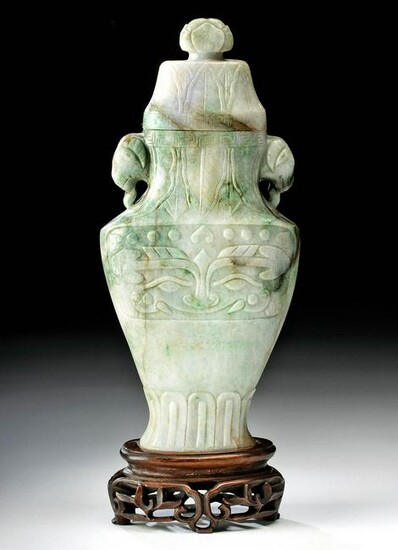Chinese Qing Jade Lidded Vase on Carved Wood Stand
East Asia, China, Qing Dynasty, ca. 18th to 19th century CE. An exquisite lidded vase, finely carved from jadeite of beautiful verdant hues ranging from nearly white to seafoam and emerald green with contrasting umber inclusions, all upon an openwork wooden pedestal base. The vessel presents an elegant curvaceous form and captivating iconography that includes a lotus bud finial, bas relief leaf motifs, and a lower border featuring a maze-like meander on the lid. The vessel below has a matching meander border, twin horned zoomorphic handles that perhaps represent goats or oxen of the Chinese zodiac, and additional leaf motifs adorning the neck. Just below the shoulder, on both the front and back of the vessel are quixotic archaic type visages - perhaps variants of the taotie mask - and at the lower end is a decorative band somewhat reminiscent of egg-and-dart patterns. A stunning urn with an attractive form and wondrous decorative program. Size: 7.875" H (20 cm); 9.5" H (24.1 cm) on included custom stand.
Chinese art has incorporated jade since the Neolithic period; quarries for nephrite, one species of jade, have been found in modern-day southern Mongolia that date to ca. 4000 BCE, and jadeite imported from Burma (modern day Myanmar) has also been coveted. The stone was prized for its hardness, its beautiful coloration, and its durability. By the third millennium BCE, we know that jade had also come to be associated with immortality. Jade was used to make a vast range of objects, from everyday household objects and decorative arts to the ceremonial suits in which Han dynasty emperors were buried – with the belief that jade would preserve the body and the soul for eternity.
Provenance: private Los Angeles County, California, USA collection, acquired by descent from the owner's father, collection amassed between 1950-1990
All items legal to buy/sell under U.S. Statute covering cultural patrimony Code 2600, CHAPTER 14, and are guaranteed to be as described or your money back.
A Certificate of Authenticity will accompany all winning bids.
We ship worldwide to most countries and handle all shipping in-house for your convenience.
#136525
Condition Report: Minute nicks to tip of lotus on lid and interior peripheries of lid and rim of vessel. Vessel is attached to stand. Overall excellent.
View it on
Estimate
Time, Location
Auction House
East Asia, China, Qing Dynasty, ca. 18th to 19th century CE. An exquisite lidded vase, finely carved from jadeite of beautiful verdant hues ranging from nearly white to seafoam and emerald green with contrasting umber inclusions, all upon an openwork wooden pedestal base. The vessel presents an elegant curvaceous form and captivating iconography that includes a lotus bud finial, bas relief leaf motifs, and a lower border featuring a maze-like meander on the lid. The vessel below has a matching meander border, twin horned zoomorphic handles that perhaps represent goats or oxen of the Chinese zodiac, and additional leaf motifs adorning the neck. Just below the shoulder, on both the front and back of the vessel are quixotic archaic type visages - perhaps variants of the taotie mask - and at the lower end is a decorative band somewhat reminiscent of egg-and-dart patterns. A stunning urn with an attractive form and wondrous decorative program. Size: 7.875" H (20 cm); 9.5" H (24.1 cm) on included custom stand.
Chinese art has incorporated jade since the Neolithic period; quarries for nephrite, one species of jade, have been found in modern-day southern Mongolia that date to ca. 4000 BCE, and jadeite imported from Burma (modern day Myanmar) has also been coveted. The stone was prized for its hardness, its beautiful coloration, and its durability. By the third millennium BCE, we know that jade had also come to be associated with immortality. Jade was used to make a vast range of objects, from everyday household objects and decorative arts to the ceremonial suits in which Han dynasty emperors were buried – with the belief that jade would preserve the body and the soul for eternity.
Provenance: private Los Angeles County, California, USA collection, acquired by descent from the owner's father, collection amassed between 1950-1990
All items legal to buy/sell under U.S. Statute covering cultural patrimony Code 2600, CHAPTER 14, and are guaranteed to be as described or your money back.
A Certificate of Authenticity will accompany all winning bids.
We ship worldwide to most countries and handle all shipping in-house for your convenience.
#136525
Condition Report: Minute nicks to tip of lotus on lid and interior peripheries of lid and rim of vessel. Vessel is attached to stand. Overall excellent.



